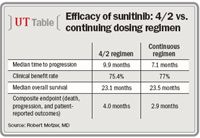Article
Continuous dose of renal cell carcinoma agent brings no added benefit
Continuous dosing of sunitinib (Sutent) proved no better than the conventional 4/2 regimen in patients with metastatic renal cell carcinoma.
Orlando, FL-Continuous dosing of sunitinib (Sutent) proved no better than the conventional 4/2 regimen in patients with metastatic renal cell carcinoma, data from a multicenter trial showed.
Response rates and survival were similar with the two dosing strategies, and continuous dosing was associated with a trend toward a briefer progression-free interval, first author Robert Motzer, MD, reported at the 2011 Genitourinary Cancers Symposium in Orlando, FL.
Standard dosing with a 2-week break between cycles had a statistically significant advantage over continuous dosing with respect to the composite endpoint of time to deterioration.
"Practicing oncologists should comply as much as possible with the sunitinib dose that has been shown to be safe and effective and should be careful about altering the dosage without the changes having been carefully studied," said Dr. Motzer, an attending physician at Memorial Sloan-Kettering Cancer Center in New York.
In a pivotal trial comparing sunitinib and interferon-alpha, patients with metastatic RCC had a twofold improvement in progression-free survival when treated with sunitinib, 50 mg/day for 4 weeks, followed by a 2-week break (J Clin Oncol 2009; 27:3584-90). The 4/2 dosing regimen subsequently received FDA approval for treatment of RCC.
Recent studies provided some evidence that continuous treatment with sunitinib at a dose of 37.5 mg/day is active and tolerable in first- and second-line treatment of metastatic RCC, Dr. Motzer said. Whether continuous dosing might offer advantages over the 4/2 regimen became the subject of a randomized clinical trial involving 292 patients with previously untreated metastatic RCC.
Patients allocated to either regimen continued treatment until disease progression or development of unacceptable toxicity. The trial's primary endpoint was time to progression.
Outcomes similar across groups

The 4/2 regimen was associated with a clinical benefit rate of 75.4%, comprising partial responses in 32.2% of patients and stable disease in 43.2%. Patients treated continuously had a clinical benefit rate of 77%, consisting of partial responses in 27.4% and stable disease in 48.6%.
Median overall survival was similar in the two groups: 23.1 months with conventional therapy and 23.5 months with continuous treatment. The composite endpoint, which comprised death, progression, and patient-reported outcomes, favored the 4/2 regimen (4.0 months vs. 2.9 months [p=.034]).
Treatment-emergent adverse events occurred in a similar proportion of patients in the two treatment groups, and few events were grade 3-4 in severity. The most common treatment-related adverse events in both groups were fatigue, nausea, diarrhea, dysgeusia, vomiting, hypertension, decreased appetite, hand-foot syndrome, mucosal inflammation, constipation, dyspepsia, and rash.
The frequency and severity of laboratory abnormalities also were similar between treatment groups.
The trial included assessment of two types of patient-reported outcomes: kidney cancer symptoms and general quality of life. Overall scores did not differ significantly between treatment groups.
Dr. Motzer disclosed a relationship with Pfizer.
Newsletter
Stay current with the latest urology news and practice-changing insights — sign up now for the essential updates every urologist needs.















